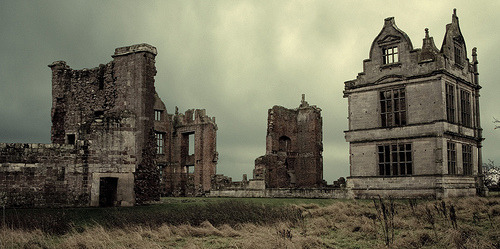Not many people have heard of the county of Shropshire. Not many people know where it is. I know where it is because it is my home county, and what a fantastic county it is. Most Salopians would argue against this because there is hardly anything to do here. However, Shropshire is a county flooded with ruined buildings, country estates and crumbling castles. And from a Dark Traveller perspective, there are many opportunities to visit some locations steeped in grim history.
In June of 2015, I visited Moreton Corbet Castle. It is located a few miles from the Shropshire town of Shrewsbury and is in the middle of the countryside. You can actually see the ruins of the old Elizabethan part of the manor house from the road, crumbling away in the distance. Very exciting.
In June of 2015, I visited Moreton Corbet Castle. It is located a few miles from the Shropshire town of Shrewsbury and is in the middle of the countryside. You can actually see the ruins of the old Elizabethan part of the manor house from the road, crumbling away in the distance. Very exciting.
The property is looked after by English Heritage but is free to visit. There is a small car park which is also free. Walking up to the ruins is eerie, especially when you are the only visitor or visiting party. Moreton Corbet Castle is old, very old, as settlements on the land were established as early as 1086. Evidence of a rich and terrible history is clear.
Moreton Corbet Castle witnessed both the Plague and the English Civil War (1642-1651). The owner, Robert Corbet, whose chosen architectural style dominates the building, died of the Bubonic Plague at the property in 1583. Parliamentary forces stormed the castle in the 1640s, damaging it (and a few Royalist soldiers) in the process.
Although damaged, the Manor House was restored and inhabited up until the early 18th century. The Corbet family still own the property but live elsewhere, leaving the house to slowly fall to nature. Ancestors of the Corbets are buried next to Moreton Corbet in the Church, St Bartholomew's and it's Churchyard.
The Church of St Bartholomew is glorious and colourful. There are a variety of effigies, tombs and dedications to the dead, including a list of those who died in the Great Wars, handwritten and displayed proudly next to the pulpit. There is a children's section with a mini library and toys watched over by skulls carved into the stone fire place.
My Dark Travels Rating - 9/10
I have given Moreton Corbet Castle this rating because it is one of my favourite places to visit. Not only is it free, it has everything that I look for in a location - creepy old ruins, steeped in history, next to a quaint village church with tombs, graves and skulls. Oh, and it is in the middle of the countryside which makes it isolated, bleak and extra creepy. It would be 10/10 if English Heritage had provided an audio tour (EH do great audio tours!). I would definitely recommend MCC to anyone interested in Dark Tourism.









